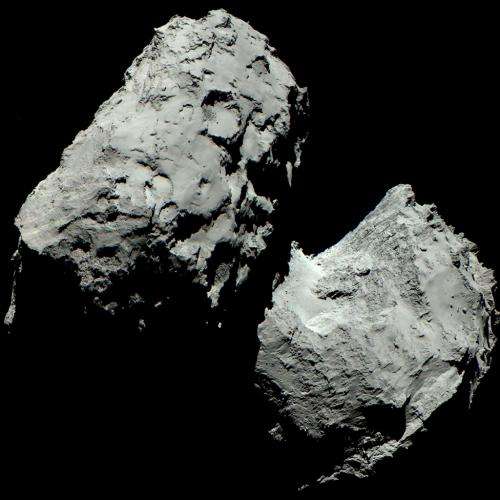September 1, 2016 report
Rosetta collects and examines space dust samples from comet 67P

A European team of researchers has reported on comet dust sample examinations being conducted by the Rosetta space probe in a letter in the journal Nature describing the types of experiments the probe has been conducting and what it has found thus far regarding space dust grains. Ludmilla Kolokolova with the University of Maryland offers a News & Views take on the work done by the team in the same journal issue.
Space dust is important to space scientists because they believe it is one of the most basic components of planets and other objects such as asteroids. Many believe that the more we learn about space dust the more we will learn about the early history of our solar system and perhaps the universe in general.
The Rosetta project involved putting a probe into orbit around comet 67P by the European Space Agency—it was launched in 2004 and took ten years to reach its target. The probe, which is still working, successfully launched a lander module called Philae to the surface of the comet, also known as Churyumov–Gerasimenko—the lander collected samples for two days before losing power. In this latest effort, the researchers have analyzed dust collected directly from around the comet by the Rosetta craft between November 2015 and February 2015. It has been doing so using an onboard device called the Micro-Imaging Dust Analysis System. They now report that they have obtained data regarding size, texture, shape and even the microstructure of particles.
The particles, the team reports, varied in size from as large as tens of micrometers to as small as hundreds of nanometers. There were also many shapes, the most important of which were single grains—the team was able to calculate the elongation of over a hundred of the dust grains—enough to confirm that they conform to theories of the size of interstellar dust particles, which suggests they represent some of the building blocks of comets and also offers some degree of optimism that someday soon, interstellar craft (such as Breakthrough Starshot) could become a reality.
The Rosetta mission is set to end on the last day of this month with a dramatic plunge into the comet it has been studying.
More information: Mark S. Bentley et al. Aggregate dust particles at comet 67P/Churyumov–Gerasimenko, Nature (2016). DOI: 10.1038/nature19091
Abstract
Comets are thought to preserve almost pristine dust particles, thus providing a unique sample of the properties of the early solar nebula. The microscopic properties of this dust played a key part in particle aggregation during the formation of the Solar System. Cometary dust was previously considered to comprise irregular, fluffy agglomerates on the basis of interpretations of remote observations in the visible and infrared and the study of chondritic porous interplanetary dust particles that were thought, but not proved, to originate in comets. Although the dust returned by an earlier mission has provided detailed mineralogy of particles from comet 81P/Wild, the fine-grained aggregate component was strongly modified during collection. Here we report in situ measurements of dust particles at comet 67P/Churyumov–Gerasimenko. The particles are aggregates of smaller, elongated grains, with structures at distinct sizes indicating hierarchical aggregation. Topographic images of selected dust particles with sizes of one micrometre to a few tens of micrometres show a variety of morphologies, including compact single grains and large porous aggregate particles, similar to chondritic porous interplanetary dust particles. The measured grain elongations are similar to the value inferred for interstellar dust and support the idea that such grains could represent a fraction of the building blocks of comets. In the subsequent growth phase, hierarchical agglomeration could be a dominant process and would produce aggregates that stick more easily at higher masses and velocities than homogeneous dust particles. The presence of hierarchical dust aggregates in the near-surface of the nucleus of comet 67P also provides a mechanism for lowering the tensile strength of the dust layer and aiding dust release.
Journal information: Nature
© 2016 Phys.org




















